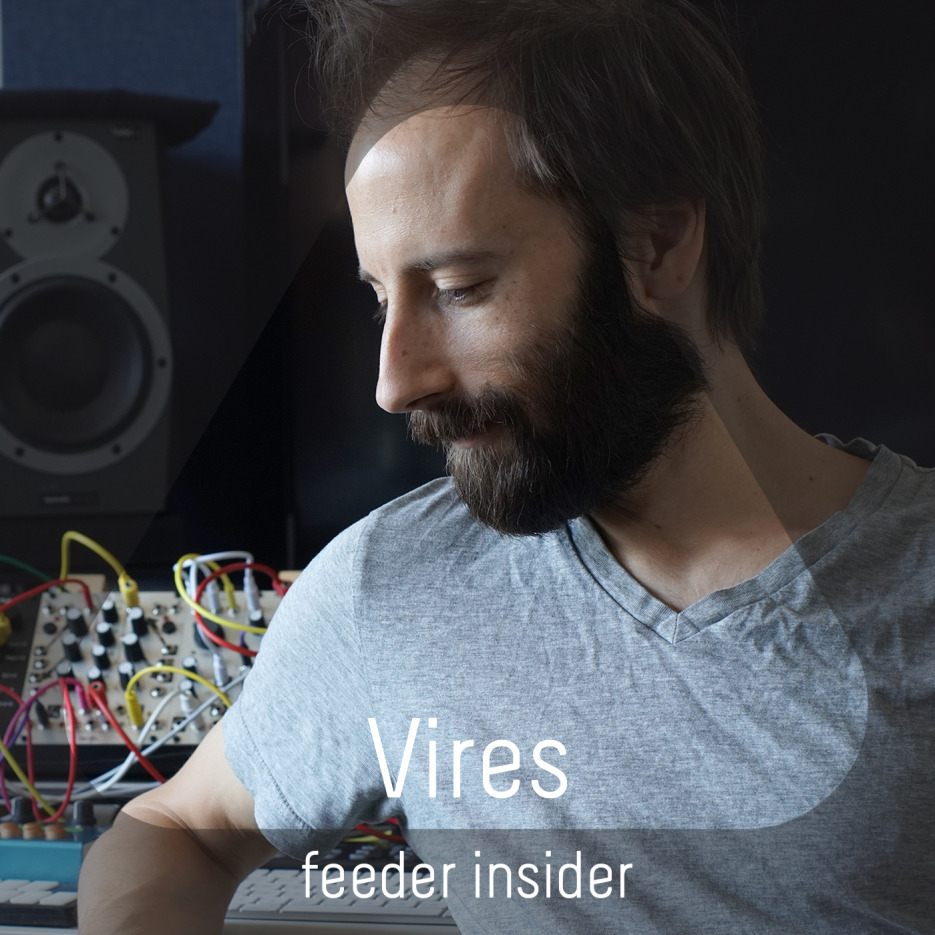In a realm where musical boundaries are constantly pushed, the pursuit of unique and captivating sounds is an endeavour cherished by many artists. Today, we delve into the enigmatic world of ambient and experimental music, where sonic landscapes are meticulously crafted to transport listeners to ethereal realms as brought forward by David aka Vires.
Embracing the analog magic delivered by tape machines, the glockenspiel as well as other inspiring devices and instruments, Vires has harnessed the evocative power of vintage technology, breathing another kind of life into his compositions in a way that is nostalgic, relaxing and groundbreaking at the same time. In an era dominated by digital production tools and streamlined processes, it is truly refreshing to witness something new. Let’s find out more about him, his vision and his music.
ambient / experimental / tapes
feeder.ro: Hello Vires, nice to have you on the feeder insider interviews series! Your music took us by surprise, as well as the concept and recording process behind your latest album, “The Glockenspiel Tapes”, which clearly stands out. What inspired you to undertake this challenge and how did you work towards your goals?
Vires: Hi, thanks for having me on. So the concept came about kind of organically as I had been experimenting with glockenspiel for a while. A friend of mine who really liked the results I was getting, sort of challenged me to make an entire album like that, using only a glockenspiel.
Every piece contains a few separate glockenspiel improvisations, recorded from start to finish onto cassette.
I played the tapes back at different speeds to achieve (for most of the pieces) a high, middle and low-pitched transposition of the original performance. There was a little bit of processing/effects for some parts, but most of it was done by just layering the transposed audio coming off the tapes. It’s funny because usually when people think of electronic music they think of synthesizers, sampling machines, drum sequencers or sometimes ambient music with a lot of reverb or other effects. I love all of that, but I wanted to do something different for this project and to keep things really minimalist, analog and as human as possible.
f: How do you combine your vintage gear with the new additions to bring forward your unique experiments?
Vires: The cassette machines I used for the album are all pretty old. Definitely vintage. The ones I used for ¼ speed playback have probably never even had the belts changed, which gives those parts the pitch warble that you hear on the lowest parts. It’s also possible the motor is about to die on them, but I’ve been keeping my fingers crossed.
I also have a Maxon AD900 which is kind of my desert island delay pedal. That pedal is all over the album – I just love the sound of it. You can actually hear it alone at the end of the second track, “Half Moon Woods”. On another track, I used a boss DS-1 that I’ve had since I was a teenager. It’s probably my favourite distortion pedal, and it just sounds perfect for certain applications.
As far as newer gear, I used some Eurorack modules to affect the sounds coming from the tape on the way into Ableton. More generally, I really like the Monome Norns for experimenting, as well as the Critter & Guitari Organelle.
Both of those devices are completely programmable, as in you can make your own little apps for them if you learn a little about how they work. I find it really inspiring to be part of a community of users that is coding and sharing different patches/scripts.
f: You use many tiny sound fragments to create small time/tape loops. Where is the line where you can consider that a loop contains too many or too few sounds?
Vires: That’s a good question and a difficult one because it all depends on the nature of the sounds and the arrangement. Sometimes I end up with a sound piece that has a lot going on, but it still feels minimalist because the sequence is simple and everything fits together. With tape loops specifically, I tend to use fewer sounds, but there’s no definitive line as far as I see it.
f: You enjoy distorting the sounds you record on tapes with different and non-musical “instruments”, like toys, plants, and glasses, resulting in unique and irregular compositions. How does the process evolve until you have found the proper elements? How many iterations and variations do you try out until the final arrangement?
Vires: Ah, I think you’re referring to one of my tape loop videos on my Instagram. I was working with longer tape loops that come out of the cassette shell and I used a tiny model of the Starship Enterprise, along with some other objects I had around the studio to wrap the tape around.


I remember struggling with that one to get the tape to run smoothly because the amount of tension on the tape needs to be just right or else it doesn’t work. It looks kind of crazy, but it actually doesn’t usually affect the sound of what’s on the tape. Sometimes if I have a shorter loop that’s less delicate I’ll manually pull on the tape to play with the tension which can give it some irregular flutters in pitch.
f: While browsing your latest album, “The Glockenspiel Tapes” and “Or Bits”, we find some common patterns. Where does your vision originate from and what are your plans regarding sonic experiments?
Vires: I think the common thread there are the types of sounds and maybe the way the pieces build up to greater and greater density as they progress. It’s only a year between the two albums so it makes sense there is some commonality between them. It’s weird to think about though, because to me the two are really, really different. Or Bits is all sequenced and on the grid.
All the instruments are synths and samples and everything is recorded direct from the hardware, through cables, into the computer. With “The Glockenspiel Tapes” it’s a human, playing an instrument, recorded with microphones. So it’s a pretty stark contrast. I guess the vision comes from whatever new instruments or ideas I’m playing around with at the time.
I recently circuit-bent an old Casio keyboard, so I wouldn’t be surprised if that appears in some of my work in the near future. And the limitations of whatever it is I’m working with. The Casio doesn’t have any midi connectivity for example.
f: Sometimes, you mix your audio compositions with video, producing multimedia artworks. What connections (or differences) have you discovered between the frequencies of light/colour and sound?
Vires: Yes there was one point in the past year or so I was very interested in audiovisual work. I sometimes get distracted by a new idea or process that interests me whether it’s making midi-reactive visuals in pure data, circuit bending or learning to code – for better or for worse, I’m interested in too many things. Sometimes I want to drop everything I’m doing and learn how to build guitar amps! Anyway, sorry if that didn’t completely answer the question (laughs). Like I said I get distracted easily.
f: You also like to incorporate in your music funny aspects, like the games with the cats. How did you come across this approach?
Vires: The cats haha! That was just a Norns script where you choose a number of cats to have and they trigger note events based on how often (and how regularly) you tell them to shoot out hairballs. You can also control the gravity in it if I remember correctly. A fun script but I don’t take any credit for it – it was written by Quixotic7. I like it when things sound weird to the point that it’s funny. I think it’s refreshing when so many people take it too seriously, and keeping a good sense of humour can lead to some refreshing creative directions.
f: While listening to your tracks, you can envision movie parts, theatre scenes or game fragments. Where do you see your work incorporated into this circuit and where to expect future live performances?
Vires: I’d like to get into the world of film/tv/game music. It’s not really what I’ve been focused on in terms of the content I’m putting out, but I’ve made short films with friends before just for fun and done the sound fx, mixing, credits music etc. I also worked with a friend recently on recording some material for a video game project he was working on. So yeah, it’s all in the cards, but I try not to mix my creative projects with thoughts of what would be marketable for tv/film/games. If someone likes some of my work and wants to use it for something, that’s great. I’m always open to work on commission too, as long as I like the project and the people involved and feel that my style/skills are a good fit.
I’m just starting to think about how I want live shows to work. I expect to have a better idea of it heading into the fall. Performances for the near future will likely be close to home in the NYC area.
That’s how I feel right now anyway. Maybe in a year or so, I’ll be touring, playing conventions and festivals though – you never know.
For more sonic delights and updates, follow Vires on Instagram and Bandcamp.
Words by ubic, nwt & AndreiB
*the copyright for the photos belongs to their respective owners and publishers
About feeder insider
feeder insider is a series of interviews that explore the universe surrounding music and visual arts while connecting the local to the international creative scene.







